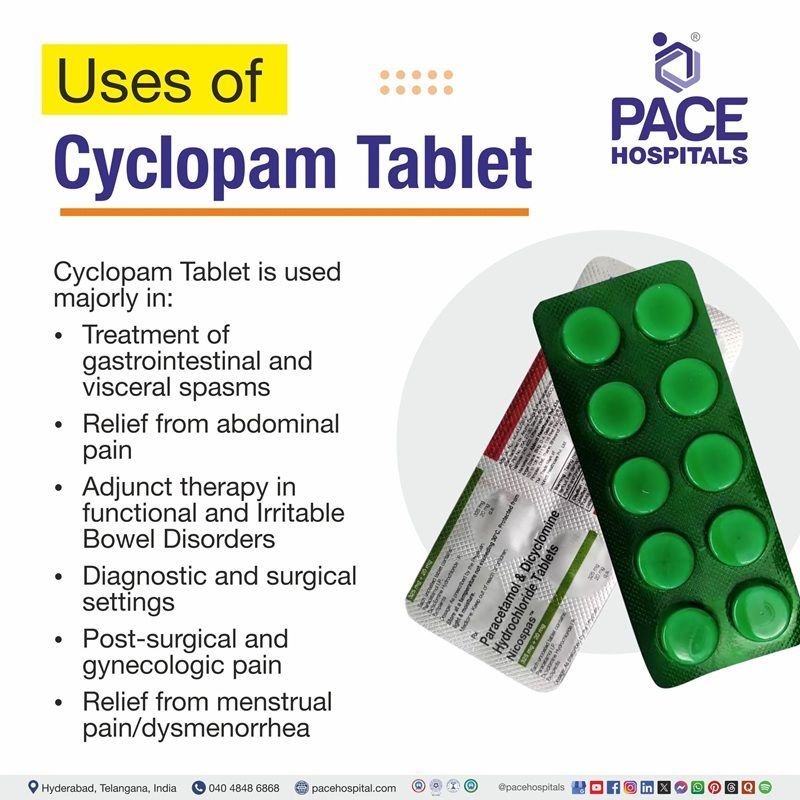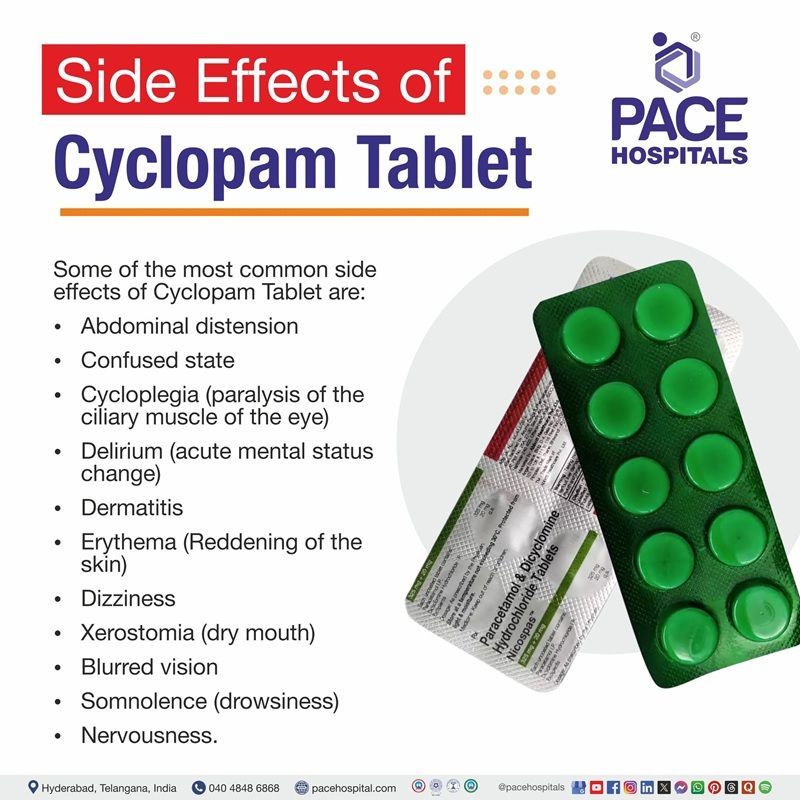Cyclopam Tablet – Uses, Side Effects, Composition, and Dosage
PACE Hospitals
Manufactured by: Indoco Remedies Ltd
Class: Combination of muscarinic receptor antagonist (antispasmodic) and prostaglandin inhibitor (analgesic/antipyretic agents).
Overview
- Cyclopam tablet is a medicine that is a combination of dicyclomine and paracetamol (acetaminophen). It is commonly available in tablet or syrup form and needs to be taken as directed by the physician.
- Cyclopam contains the properties of antispasmodics, analgesics, and antipyretics. It is used to manage abdominal cramps, renal and biliary colic, and pain from gynaecologic or surgical conditions. It is used to manage functional bowel disease and irritable bowel syndrome (IBS).
- Cyclopam tablets work by inhibiting the pain and inflammation and relaxing muscles to improve cramps and spasms. It also helps treat spasmodic pain associated with kidney stones or gallbladder stones, blockages in the intestine, or menstrual pain and cramps.
- Dicyclomine (or dicycloverine) is an antispasmodic and anticholinergic agent that blocks the action of acetylcholine, reducing pain, gastrointestinal secretions, and intestinal motility. It is mainly used to treat gastrointestinal conditions involving pain and spasms, such as irritable bowel syndrome. Paracetamol provides analgesic and antipyretic effects, reducing pain, fever, and inflammation.
Cyclopam Tablet Composition
- Each Cyclopam tablet contains Dicyclomine Hydrochloride 20 mg and Paracetamol 500 mg (immediate-release).
- Packaging – Strip of 15 tablets.

Cyclopam Tablet Uses
The cyclopam tablet uses, which contain dicyclomine hydrochloride and paracetamol (acetaminophen), are as follows:
Treatment of gastrointestinal and visceral spasms
- Cyclopam is indicated for the relief of gastrointestinal smooth muscle spasms caused by conditions such as irritable bowel syndrome (IBS), biliary colic, renal colic, and intestinal colic.
- The dicyclomine component acts as a muscarinic receptor antagonist, inhibiting acetylcholine-induced spasms and relaxing the muscles of the gut, thereby alleviating cramps and pain.
- The paracetamol component provides analgesic and antipyretic effects, thereby reducing fever and addressing associated pain and inflammation.
Relief from abdominal pain
- Cyclopam tablet is used for managing abdominal pain associated with functional bowel disorders. It helps by relaxing the smooth muscles and blocking pain signals, improving patient comfort during episodes of spasms and cramping related to gastrointestinal conditions.
Adjunct therapy in functional and irritable bowel disorders
- Cyclopam is usually prescribed alongside dietary and lifestyle interventions to provide symptomatic relief of recurrent abdominal pain and discomfort in functional bowel disorders. It is not curative but aids in symptom control.
Use in diagnostic and surgical settings
- It may be administered before diagnostic gastrointestinal procedures or surgeries to minimise spasms and facilitate examination or intervention.
Post-surgical and gynecologic pain
- Cyclopam can be used to treat smooth muscle spasms associated with gynaecologic conditions or spasmodic pain from surgical procedures.
Cyclopam Tablet off-label uses
- It also helps to get relief of menstrual pain (dysmenorrhea) by relaxing the smooth muscles in the uterus and blocking pain signals, improving patient comfort during episodes of spasms and cramping.
Guidelines to follow while taking the Cyclopam Tablet
- Cyclopam tablet is advised to be taken with or without food, preferably as prescribed by the doctor, usually three times a day.
- It is recommended to swallow the tablet whole with a full glass of water.
- If stomach upset occurs, it can be taken with food or antacids to minimise discomfort.
- Dose adjustments may be needed for children under 14 years and elderly patients over 65 years.
- If a dose is missed, patients are advised not to take a double dose; they need to take the next dose at the same regular time.
- It is recommended to avoid alcohol as it can increase drowsiness and side effects.
- It is generally advisable to use this for no longer than the prescribed duration, usually not exceeding 3 weeks.
- Patients are advised to inform the doctor if they have any allergies, heart problems, glaucoma, liver or kidney diseases, or if women are pregnant or breastfeeding.
- Patients need to be cautious with driving while taking cyclopam as it may cause drowsiness or dizziness.
- Possible side effects include dry mouth, dizziness, nausea, constipation, and blurred vision. So these side effects need to be monitored by the individuals.
- In case of overdose, individuals need to immediately seek medical help or contact a poison control centre.
Cyclopam Tablet Mechanism of Action
Cyclopam tablet contains two active ingredients, dicyclomine and paracetamol, which work synergistically to relieve pain and muscle spasms. This combination allows Cyclopam to target both the muscular and pain components of gastrointestinal and related conditions effectively.
- Dicyclomine (antispasmodic): Dicyclomine acts as a muscarinic receptor antagonist by blocking the stimulation of smooth muscles by acetylcholine, mainly in the gastrointestinal (GI) tract. By reducing smooth muscle contractions, it decreases intestinal motility and secretions, resulting in muscle relaxation and relief from cramps and spasms. This action is crucial in alleviating symptoms caused by muscle spasms in various organs, including the intestines, stomach, uterus, urethra, and bile ducts.
- Paracetamol: It inhibits the COX-1 and COX-2 (cyclooxygenase) enzymes, resulting in a decrease in prostaglandin (PG) synthesis, which mediates pain and inflammation. Acting primarily in the central nervous system (CNS), paracetamol raises the pain threshold and reduces fever, thereby contributing to overall relief of discomfort and associated symptoms. This central mechanism complements the peripheral antispasmodic effects of dicyclomine.
- Combined effect: The dual action of muscle relaxation by dicyclomine and pain/fever reduction by paracetamol makes Cyclopam highly effective for treating abdominal pain, cramps, spasms, and associated fever. Due to this combination, Cyclopam is widely used in clinical scenarios like irritable bowel syndrome, biliary colic, renal colic, and dysmenorrhea, providing both symptom relief and improved quality of life.

Cyclopam Tablet Side Effects
The majority of cyclopam tablet side effects fade away as the body gets accustomed to the drug. However, it is not recommended to drive when a person is under medication. Abstaining from alcohol is advised as it interacts with the drug and leads to poor quality of sleep.
The following side effects may or may not occur during the use of the Cyclopam tablet. It is usually well-tolerated when taken in the prescribed dosage. The side effects of Cyclopam tablet are generally mild and may include:
- Abdominal distension
- Confused state
- Cycloplegia (paralysis of the ciliary muscle of the eye)
- Delirium (acute mental status change)
- Dermatitis
- Erythema (Reddening of the skin)
- Fatigue
- Hallucinations
- Insomnia (sleep disorder)
- Malaise
- Palpitation (abnormal heart rhythm)
- Rash
Serious side effects may include:
- Dizziness
- Xerostomia (dry mouth)
- Blurred vision
- Somnolence (drowsiness)
- Nervousness
- Weakness
NOTE: If any of the above symptoms are noticed, it is recommended to contact the concerned doctor immediately.
Cyclopam Dosage and Safety Guidelines
Cyclopam tablet dosage is prescribed by the general physician, usually based on the patient’s age, weight, and disease symptoms.
Cyclopam tablet dosage for adults
- Dicyclomine is available as 20 mg, and paracetamol is available as 500 mg, which is taken once a day (OD) for irritable bowel syndrome (IBS) in the intramuscular (IM) route. For all the other indications, it can be taken orally. The standard frequency of dicyclomine is usually not more than 1-2 days; replace Intramuscular with oral as soon as possible.
- Dicyclomine is not recommended to be administered via the intravenous route.
Pediatric dose of cyclopam
- Dicyclomine syrup is available as 10 mg, and the pediatric dose is 10 mg per oral (PO), not to exceed 40 mg/day; it needs to be given 30-60 minutes before a meal. Cyclopam tablet is not recommended for use in children under 10 years of age. It is used in children up to 1 year or above 6 months of age.
Cyclopam dose for geriatrics
- In the case of geriatrics suffering from irritable bowel syndrome (IBS), 10-20 mg of the drug PO can be given by increasing the dose gradually, not exceeding 160 mg/day. However, it is restricted from administering the drug via the intramuscular route.
- Since the drug is an anticholinergic agent, it needs to be used with caution in geriatric population as the increased anticholinergic drug activity might lead to adverse effects like dementia.
Cyclopam Dosage for Specific Patient Population
- Hepatic impairment: In patients with liver disease, cyclopam must be used cautiously. Liver impairment might decrease the metabolism of the medication, causing it to accumulate in the body and increasing the risk of toxicity and adverse reactions. However, dose adjustments are frequently required depending on the severity of the liver condition, and a doctor must regularly monitor the patient.
- Renal impairment: For renal disease patients, especially those with chronic kidney disease (CKD), cyclopam clearance may be reduced. This can cause the drug to build up in the system, potentially resulting in increased side effects or toxicity.
Dose reduction and careful monitoring are advised to avoid complications. It is important that patients with liver or kidney problems consult their doctor before using Cyclopam and follow the prescribed doses strictly to ensure safe and effective treatment.
Effects of Cyclopam in Pregnancy and Breastfeeding
Cyclopam during pregnancy
Cyclopam may be used during pregnancy; there is no known risk of fetal harm based on human data with short-term use.
Cyclopam during breastfeeding
- Dicyclomine or Dicycloverine: This drug may pass through breast milk and may cause breathing problems in breastfed infants younger than 6months. Therefore, it is recommended to inform the doctor in case of breastfeeding an infant during the treatment.
- Paracetamol (Acetaminophen): Paracetamol can be used during pregnancy with no known risk for breastfed infants based on human studies with the oral form. However, no human data is available to evaluate the effects on milk production
Cyclopam Overdose
- Cyclopam overdose can cause symptoms like blurred vision, dry mouth, nausea, confusion, dizziness, irregular heartbeat, and, in a few severe cases, seizures or respiratory problems.
- Immediate medical attention is necessary if an overdose is suspected. Treatment includes supportive care, stomach pumping (gastric lavage), administration of activated charcoal to reduce drug absorption, and monitoring. Avoid exceeding the prescribed dose and seek emergency help if an overdose is suspected.
Cyclopam Contraindications
Cyclopam tablet is contraindicated in the following conditions:
- It is contraindicated in patients who have hypersensitivity to Cyclopam or any of its ingredients.
- It is recommended not to be used in patients with obstructive uropathy or gastrointestinal obstruction.
- Use is contraindicated in individuals with glaucoma or increased intraocular pressure.
- It is contraindicated in patients with severe ulcerative colitis and myasthenia gravis.
- Cyclopam is not recommended for patients with severe liver or kidney disease due to altered drug metabolism and potential toxicity.
- It is recommended to be avoided in children under 6 months of age.
- Use during breastfeeding is not recommended unless prescribed by a doctor.
- Patients with an enlarged prostate or urinary retention disorders must avoid Cyclopam.
- Always consult a healthcare professional before use if any of these conditions exist.
Warnings and Precautions of Cyclopam Tablet
- General: Use cyclopam with caution in patients with hepatic or renal disease; dose adjustments may be necessary. Avoid consumption of alcohol during treatment as it may increase drowsiness and the risk of stomach irritation. It may cause dizziness, blurred vision, drowsiness, and weakness.
- Pregnant and breastfeeding: It is recommended that women use Cyclopam only under medical supervision.
- Gastrointestinal: Take cyclopam with food to minimise stomach upset. It is not recommended for patients with intestinal obstruction, severe ulcerative colitis, or reflux esophagitis.
- Ophthalmologic: Avoid in patients with glaucoma or increased intraocular pressure.
- Genitourinary: Use cautiously in patients with urinary retention, obstructive uropathy, or enlarged prostate.
- Allergic reactions: Avoid use if hypersensitive to any ingredients.
- Driving and operating machinery: Exercise caution due to severe visual disturbance and sedation.
Patients are advised to follow their physician's instructions carefully and report any severe or adverse side effects.
Cyclopam Tablet Interactions
A drug interaction is a reaction between two or more drugs, whereas a food interaction is a reaction between the food and the drug. In the case of an interaction between a disease and a drug, it is called a disease-drug interaction.
Drug interactions
It is important to inform the doctor about the drugs if the patient is using any of the following classes along with cyclopam:
- Anticholinergic drugs: Using Cyclopam with other anticholinergic medications such as antihistamines like diphenhydramine, antipsychotics (phenothiazines), tricyclic antidepressants, benzodiazepines, narcotic analgesics (meperidine), amantadine, quinidine, nitrates, and sympathomimetics may increase anticholinergic side effects. These include dry mouth, blurred vision, constipation, difficulty urinating, and increased heart rate. There is also a risk of anticholinergic toxicity, which can be severe.
- Glaucoma medications: Cyclopam can reduce the effectiveness of glaucoma drugs like latanoprost, timolol, and dorzolamide and increase the risk of angle-closure glaucoma. It is contraindicated in patients with glaucoma.
- Drugs affecting gastrointestinal motility: Cyclopam slows gut motility and may counteract the effects of medications like metoclopramide, erythromycin, and tegaserod used to enhance GI movement.
- Digoxin: Use with caution, cyclopam may increase digoxin side effects such as visual disturbances, irregular heartbeat, and nausea.
- Antacids: Antacids may decrease cyclopam absorption, potentially decreasing its effectiveness. Doses have to be spaced apart.
- Warfarin: No significant interaction reported, but monitoring is advised.
- Other CNS depressants: Combining cyclopam with benzodiazepines, opioids, or other sedatives can enhance drowsiness.
Disease interactions
A person is contraindicated from taking the cyclopam drug if the patient is suffering from any of the following disease conditions:
- Myasthenia gravis
- Glaucoma
- Obstructive uropathy
- Obstructive disease of the gastrointestinal tract
- Serious ulcerative colitis
- Reflux esophagitis
These diseases are treated with antimuscarinic agents, which will eventually exhibit anticholinergic properties, which are not recommended to use along with cyclopam to avoid adverse effects like dementia.
Food interactions
It is recommended to avoid alcohol while taking Cyclopam, which may increase drowsiness and dizziness.
Cyclopam tablet storage
Cyclopam tablet needs to be stored in a cool and dry place away from direct sunlight at room temperature.
Frequently Asked Questions (FAQs) on Cyclopam Tablet
What are the uses of the Cyclopam tablet?
Cyclopam tablet is a combination medicine used for treating abdominal pain and cramps. It is also used to treat biliary colic, intestinal colic, renal colic, spasmodic dysmenorrhea (painful, irregular periods), and irritable bowel syndrome (IBS) symptoms.
How to use the cyclopam tablet?
Cyclopam tablet needs to be taken orally with or without food. It is generally recommended to have the tablet after a meal to decrease the risk of stomach upset. The drug usage can be discontinued if the patient gets diarrhea while under the cyclopam medication.
Can cyclopam be taken with the ofloxacin tablet?
Yes, the patients can use cyclopam along with ofloxacin. The cyclopam contains dicyclomine and paracetamol, used primarily for relieving abdominal pain, whereas ofloxacin is a fluoroquinolone antibiotic used to treat several bacterial infections. Hence, it is usually considered safe to take these medications together. However, it is suggested to discuss with the physician before taking these two drugs together, as they might cause side effects such as nausea and dizziness.
Can cyclopam tablet be taken with pantoprazole?
Yes, pantoprazole can be taken along with cyclopam, as pantoprazole is a proton pump inhibitor used for medical conditions like gastroesophageal reflux disease (GERD) and is well tolerated in patients without interfering with the therapeutic outcome of cyclopam.
Can I take cyclopam tablet for periods?
Yes, it can relieve cramps and pain during and before the menstrual cycle. The chemical composition of dicyclomine and paracetamol alleviates the abdominal cramps and discomfort associated with the menstrual cycle, where dicyclomine acts as an antispasmodic by relieving the smooth muscles of the uterus, and thereby reducing cramps and spasms during menstruation. Paracetamol shows analgesic effects.
Is cyclopam tablet used for burning sensation during urination?
No, cyclopam is usually not suitable for treating burning sensations during urination, as this drug often involves urinary retention in patients.
What is the standard dose of cyclopam?
Cyclopam tablet contains 20 mg of dicyclomine hydrochloride and 500 mg of paracetamol per unit dose. However, the dose may be altered in case of special populations like children, older adults, pregnant and lactating women.
Is cyclopam tablet safe to use in pregnant women?
Yes, with the antispasmodic activity of cyclopam, the drug is generally considered safe to use without any teratogenicity. However, it can be used only for the spasmodic indication and prescribed by the doctor.
What happens when cyclopam tablet is taken with alcohol?
Cyclopam may increase drowsiness and dizziness while the patient is under the influence of alcohol. It is recommended to avoid consuming alcohol while taking the medicine, as it increases the risk of abdominal flatulence and visual disturbances.
Can I use antacids with cyclopam tablet?
Usually, the antacids decrease the gastric acid secretions, which in turn influences the normal kinetics of cyclopam. Thus, concomitant administration of antacids with cyclopam would lead to subtherapeutic outcome or therapeutic failure of cyclopam drug. Hence, it is not recommended to use cyclopam with any drug from the antacid class.
Can the use of cyclopam tablet cause diarrhea?
Yes, the use of cyclopam tablet can cause diarrhea. In such a case, drink plenty of water and other fluids by taking small, frequent sips. Also, avoid taking fatty and fried food along with this medication. Talk to the physician if diarrhoea persists and you notice any signs of dehydration, such as decreased urination with dark-coloured and strong-smelling urine.
What is the best time to take cyclopam tablet?
Cyclopam tablet may be taken with or without food. However, taking it with food for the prescribed duration at a fixed time is generally recommended to help prevent potential stomach upset.
Can the use of cyclopam tablet cause liver damage?
Yes, as the chemical composition of cyclopam contains paracetamol, it is generally not prescribed to patients with liver disorders due to the hepatotoxic property of paracetamol.
Is cyclopam good for stomach pain?
Yes, stomach pain is one of the major indications of cyclopam, as this drug is an antispasmodic agent with analgesic property. When used in patients with abdominal discomfort, the drug helps in relaxing the smooth muscles of the gastrointestinal tract, thereby alleviating the cramps and associated abdominal discomfort.
Does cyclopam tablet be used for burning sensation during urination?
No, cyclopam is usually not suitable for treating burning sensation during urination as this drug often involves urinary retention in patients.
What is the standard dose of cyclopam?
Cyclopam tablet contains 20 mg of dicyclomine hydrochloride and 500 mg of paracetamol per unit dose. However, the dose may be altered in case of special population like children, elderly people, pregnant and lactating women.
What happens when cyclopam tablet is taken with alcohol?
Cyclopam may increase the drowsiness and dizziness while the patient is under the influence of alcohol. One should avoid consuming alcohol while taking the medicine increases the risk of abdominal flatulence and visual disturbances.
Share on
Request an appointment
Fill in the appointment form or call us instantly to book a confirmed appointment with our super specialist at 04048486868











